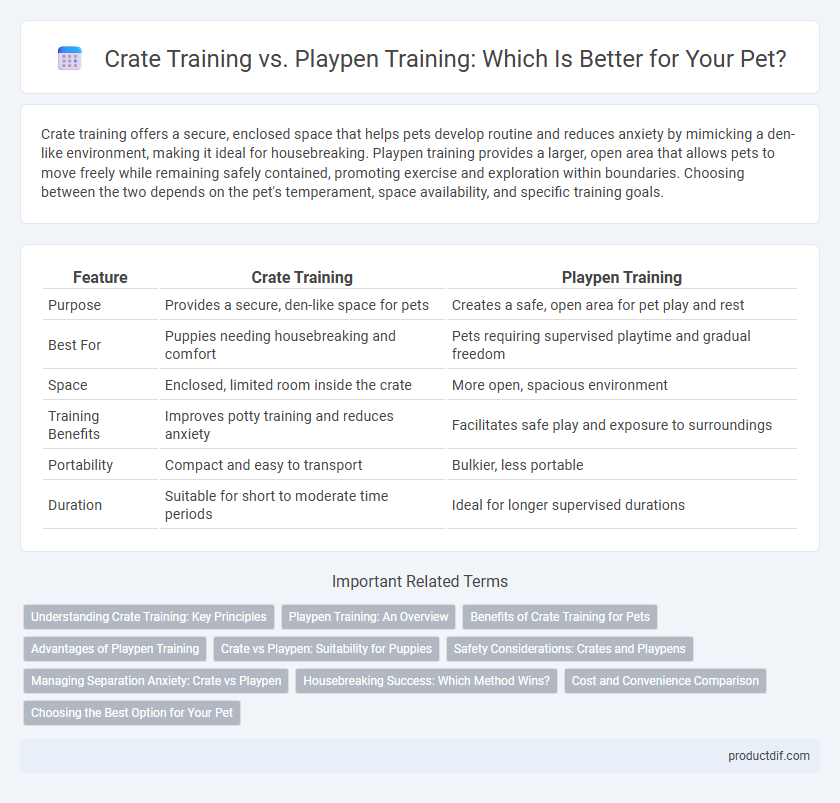Crate training offers a secure, enclosed space that helps pets develop routine and reduces anxiety by mimicking a den-like environment, making it ideal for housebreaking. Playpen training provides a larger, open area that allows pets to move freely while remaining safely contained, promoting exercise and exploration within boundaries. Choosing between the two depends on the pet's temperament, space availability, and specific training goals.
Table of Comparison
| Feature | Crate Training | Playpen Training |
|---|---|---|
| Purpose | Provides a secure, den-like space for pets | Creates a safe, open area for pet play and rest |
| Best For | Puppies needing housebreaking and comfort | Pets requiring supervised playtime and gradual freedom |
| Space | Enclosed, limited room inside the crate | More open, spacious environment |
| Training Benefits | Improves potty training and reduces anxiety | Facilitates safe play and exposure to surroundings |
| Portability | Compact and easy to transport | Bulkier, less portable |
| Duration | Suitable for short to moderate time periods | Ideal for longer supervised durations |
Understanding Crate Training: Key Principles
Crate training involves creating a secure, confined space that mimics a den, promoting a pet's natural instinct for safety and comfort. This method relies on positive reinforcement to encourage pets to view the crate as a safe retreat, aiding in housebreaking and reducing anxiety. Understanding key principles such as gradual introduction, appropriate crate sizing, and consistency ensures effective crate training outcomes.
Playpen Training: An Overview
Playpen training offers a flexible and spacious environment for pets, promoting safety and comfort while allowing freedom of movement. Unlike crate training, playpens reduce stress by providing room for play, rest, and exploration, making them ideal for puppies and small dogs during housebreaking and behavioral training. Durable materials and portable designs enhance convenience for pet owners, supporting effective supervised containment.
Benefits of Crate Training for Pets
Crate training offers pets a safe, secure space that mimics a den, reducing anxiety and promoting housebreaking success. Pets learn boundaries and develop a routine, which enhances their overall behavior and comfort during travel or vet visits. The controlled environment of a crate minimizes destructive tendencies and supports consistent training efforts for puppies and adult dogs.
Advantages of Playpen Training
Playpen training offers pets a larger, safer space for movement, promoting natural exercise and reducing anxiety compared to confined crates. It facilitates easier supervision and social interaction while preventing destructive behavior in puppies or small dogs. The versatility of playpens enhances gradual training, making it an ideal choice for developing independence and confidence in pets.
Crate vs Playpen: Suitability for Puppies
Crate training provides a secure, den-like space ideal for puppies to develop bladder control and feel safe, reducing anxiety and destructive behavior. Playpens offer a larger, enclosed area that allows more freedom for exploration and play while still containing the puppy safely. For early training stages and nighttime confinement, crates are more suitable, whereas playpens are better for supervised playtime and socialization.
Safety Considerations: Crates and Playpens
Crate training offers a secure, enclosed space that prevents pets from accessing hazardous areas, reducing the risk of injury or ingestion of harmful substances. Playpens provide a larger, supervised environment that allows pets to move freely while still controlling their exposure to potential dangers. Both methods enhance safety by limiting unsupervised exploration, with crates being ideal for confinement and playpens suited for monitored playtime.
Managing Separation Anxiety: Crate vs Playpen
Crate training provides a secure, den-like environment that helps reduce separation anxiety by promoting a feeling of safety and routine for pets. Playpens offer more space and freedom, which can either alleviate stress or increase anxiety depending on the pet's temperament. Choosing between a crate and playpen for managing separation anxiety depends on the individual dog's comfort with confinement and ability to self-soothe.
Housebreaking Success: Which Method Wins?
Crate training offers a controlled environment that mimics a den, encouraging pets to hold their bladder and leading to faster housebreaking success due to their natural avoidance of soiling their sleeping area. Playpen training provides more freedom but requires consistent supervision to prevent accidents, often resulting in a longer housebreaking period. Studies show crate training typically results in quicker and more reliable housebreaking outcomes compared to playpen training.
Cost and Convenience Comparison
Crate training offers a cost-effective and space-saving solution, often requiring only a one-time purchase of a durable crate, making it ideal for pet owners with limited budget or living space. Playpen training, while generally more expensive upfront due to larger size and multiple panels, provides greater flexibility for pets to move freely and can double as a safe play area both indoors and outdoors. Convenience factors include ease of cleaning and portability, with crates typically being easier to transport and maintain, whereas playpens offer quick setup and expanded containment but may require more storage space.
Choosing the Best Option for Your Pet
Crate training provides a secure, den-like environment that helps pets develop house-training skills and reduces anxiety by establishing clear boundaries. Playpen training offers more space for movement, making it ideal for pets needing room to explore while still maintaining a confined area for safety. Selecting the best option depends on your pet's size, temperament, and specific training goals to ensure comfort and effective behavior management.
Crate Training vs Playpen Training Infographic

 productdif.com
productdif.com